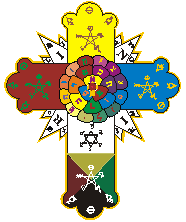| We know from the historical discussion that Alchemy is ancient.
While much of the influence on medieval alchemy was Arabic, through Gerber
and others, Alchemy returned to Europe early, through the work of Paracelsus
and others.
Real Alchemy
It is important to understand that the point of alchemy is not "turning
iron into gold," or in general any other mundane goal. Certainly
there is the philosophy of alchemy and the applied science, but even the
applied science is not wholly aimed at any specific operation.
Alchemical thought is related to Neo-Platonic thought. If there
is one central concept in Alchemy it is that the physical reality of our
universe mirrors the spiritual reality of our universe.
The Alchemist endeavors, through a series of procedures, to produce
the "Great Work" or Philosopher's Stone. What is the Philosopher's
Stone? It is a physical substance of ultimate purity. It is
the basic perfect solid, of which all other solids are impure corruptions.
At the same time, the soul of the Alchemist is refined and purged of purity
- thus the one process is the mirror and visible symbol of the other.
It is true that the obvious implication of the process is that base
metals can be "transmuted" or "purified" into higher metals. The
Alchemical view of the universe predates the periodic table - to the Alchemist,
Iron is not a separate metal, but the same universal substance as Gold,
only with greater impurity. Silver and Gold are held to be the highest,
purest, of elements. It is a logical extrapolation that Silver and
gold can be produced by "transmuting" base metals - the process of transmutation
in minerals is assumed to be the equivalent of the process of fermentation
in the vegetable kingdom.
Certainly there is a great deal of miscellaneous chemical lore caught
up in Alchemy, and the "Great Work" is no more the only aim of the Alchemist
than the "Knowledge and Conversation of the Holy Guardian Angel" is the
only aim of the Ritualist.
Common themes in Alchemy were the creation of the Elixir of Life, which
would prolong human life indefinitely, and the creation of artificial life,
or homonculi. Both of these practices survived into the Victorian
era, and the entire Rosicrucian myth - which begins with the concept of
several hundred year old magi, assumes the existence of the Elixir of Life.
But to simply mix the ingredients in Alchemy was pointless. Unless
the temperament of the Alchemist was in harmony with the result, the operation
would not be successful. Thus the discipline of Alchemy complimented
the ritual disciplines of the Golden Dawn closely.
Technical Aspects:
All elements of the vegatable and mineral kingdom contain positive and
negative force.
-
The positive force is quintessence or "Mercury."
-
The negative force is the salt
-
The positive force of all vegetable matter is the same, and that of all
mineral matter the same
-
The negative force, or salts differ.
Alchemists work with three elements: Sulphur, Salt, and Mercury.
Alchemical sulphur is not the same as common brimstone, and neither is
Salt common sodium chloride, or alchemical mercury quicksilver.
Sulphur is found in its oily form adhering to the Mercury of a substance.
In mineral alchemy it must be separated from the Mercury, but in vegetable
alchemy it is usually satisfactory to leave it combined with the Mercury.
Thus in most vegetable alchemical operations there are two elements (the
Mercury and Sulphur combined) and the Salt.
Processes of Vegetable Alchemy:
These processes aim at making an "extract"
-
Macreation - the herb is soaked in water and left standing at room temperature
-
Circulation - the herb is "percolated" in a condenser
-
Extraction- the herb is put in a Soxhlet Extractor
Alcohol is generally the "essence" or spirit of the thing from which it
is extracted. Thus grain spirits are the "essence of grain." In alchemy,
the Spirit of Wine is invariably used. There are many particulars
for this.
-
Take alcohol
-
Rectify the Alcohol
-
Grind the Herb using a mortar and Pestle
-
Place the Herb in the extraction apparatus
Soxhlet Extractor and Condenser pictured at Right |
|
 |
Alchemical Symbols:
Alchemists are accustomed to using a common "shorthand" for recording
their work, and as well may use codes and ciphers. A few of the most
common are given here. Click
Here to pursue several pages that show some of the more common alchemical
symbols
Mineral Alchemy:
Having given a bit of background on vegetable alchemy, I'll give an
illustrative example of mineral alchemy. A
Treatise of Mercury and Philosophers Stone by Sir George Ripley.
You'll get the impression that it is more complex
Glossary
A Good Glossary
of Basic Alchemical Terms
Further Resources
Alchemy Resources

Back to Bluesheets
Return to
VIA / Return to GoldenDawn
Homepage
|

